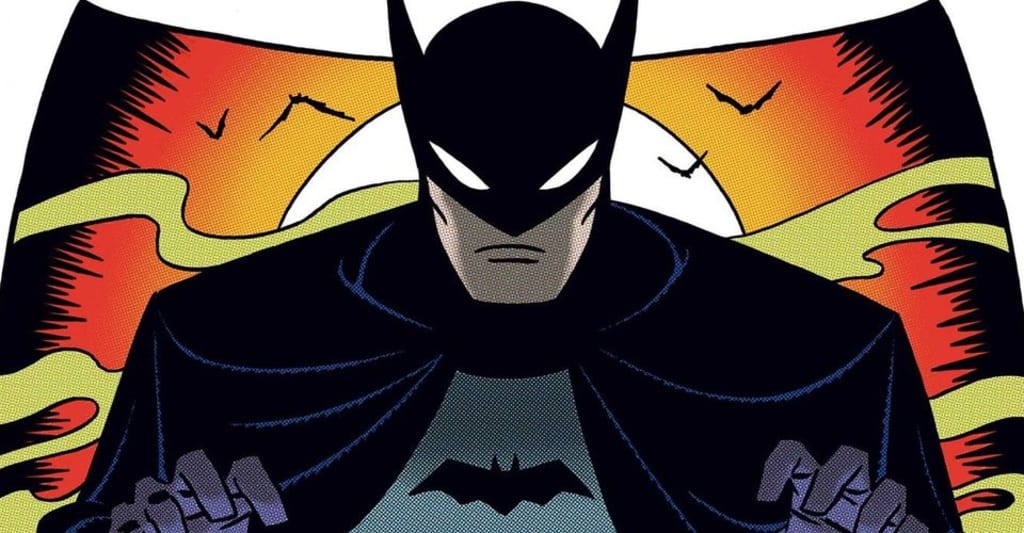
Die-hard fans know of Batman's stringent no kill rule. Time and time again you will hear fans quick to mention this, when skeptics ask why doesn't Batman just kill the Joker. They are vocal with the films as well, when Batman kills under the likes of Tim Burton and Zack Snyder. Christopher Nolan reassures these same fans when Batman asserts that he will not take a life. However, Batman was not originally born with this moralistic view of not killing his enemies. Believe it or not, in his first year of publication of Year One as some Bat-fans may want to call it, he has something of a lucrative body count.
Detective Comics #27
This is Batman's debut in April 1939, with "The Case of The Chemical Syndicate". Our first story here is an odd one, centering on more white-collar crime and corporate espionage to a degree, if you want to call it that. After the murder of Steven Crane, the murderer flees the scene, out the window, climbing up to the roof to find his partner and...The Bat-Man! The partner just gets an uppercut to the face. Yet, Batman headlocks the murderer and throws him off this two-story roof. We see him, face in the pavement two panels later.
We find the man behind this case is Alfred Stryker, who hoped to take control of the Apex Chemical Corporation when he wipes out all of the men who would share in it. He draws a gun but receives a punch from The Batman. Stryker falls back and stumbles over the railing "right into the acid tank!" Sure, Batman does not deliberately throw the man into the acid tank, but his remark of "A fitting ending for his kind" does not send signals of a man concerned with the value of human life.

Detective Comics #28
"Frenchy Blake's Jewel Gang" is hardly a memorable story. The title says it all, as Batman goes up against a gang of run-of-the mill jewel thieves. Right on the first page his body count continues. Batman gets the drop on one of the criminals. Yet, the other one draws a knife in hopes to stab Batman as he recovers. Instead, Batman uses his legs to pick up the assailant and throw him up and off the roof.
Now some people may notice another thug in the story, with a similar suit to this victim of Batman's. Hence, maybe this man was a survivor you may speculate. However, Frenchy Blake confirms it for us as he reads the newspaper regarding this story and comments "Ricky is dead..." and therefore the man in the same suit, well... maybe twins, go to the same tailor or Bob Kane was just lazy.
Detective Comics #29
The third installment of the Batman stories with "The Batman Meets Doctor Death". Here, this mad scientist Doctor Karl Hellfern, has concocted a deadly pollen that can lead to death. Through use of the newspaper, he invites Batman in hopes to kill him off before he can execute his plan. The scheme is to extract money from the rich or everyone will face death from his deadly pollen.
After encounters with thugs and the doctor's servant, Jabah, Batman finally tracks Doctor Death down to his lab. He lassos a rope around Jabah's neck, pulling himself up and through the window, stories up. Hard to say how Jabah came to be of this attack. Batman flings a fire extinguisher as Doctor Death in his lab of various chemicals. A fire erupts causing Doctor Death to burn, Batman simply laments "Death...to Doctor Death!" Again, no value for human life whatsoever. With Jabah he was either hung outside that window or left in the lair with the fire. Keep racking that body count up Batman!
Detective Comics #30
Doctor Death's servant, the Cossack, Mikhail has surfaced. Batman gets the drop on Mikhail in his crime of robbing an elderly woman. However, he lets Mikhail get away so he can track down Mikhail's boss. Batman tracks Mikhail back to an apartment he is staying at. Upon his arrival Batman uses his trademark gas-gun of the time. Eventually Mikhail comes to his senses and runs Batman out the window with a gun. The Dark Knight swings out but makes his way back, swinging in as Mikhail looks out the window, looking for Batman. The Caped Crusader swings in with a powerful kick as Mikhail pokes his head out the window. "There is a sickening snap as the Cossack's neck breaks under the mighty pressure of the Batman's foot." Right there on the panel, it reads Snap! as Batman delivers this fatal blow and offers no remorse.
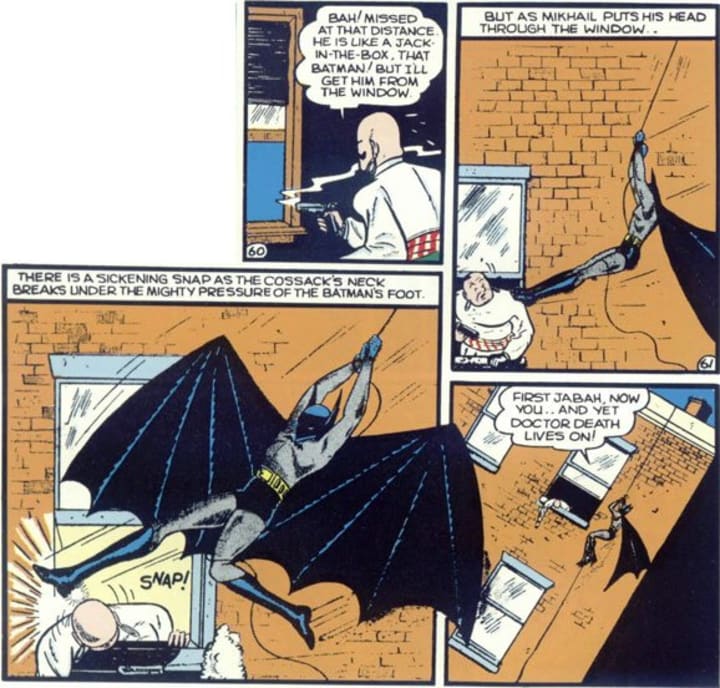
Detective Comics #32
You have seen it! That historic cover of Detective Comics #31! It's a collector's item and has received homages with Neal Adam's covers to Batman#227 and Detective Comics #49. "Batman Versus The Vampire, Part Two" is the continuation of that iconic cover. Our vampire, the Mad Monk has kidnapped Bruce Wayne's fiancé, Julie Madison and taken her to Hungary. Julie Madison is cursed, after being bitten by Dala and is a mindless slave to the Mad Monk.
By the end of the story Batman melts a silver statue to forge two silver bullets. He has to break the curse in order to return Julie Madison to life, so to speak. After forging these silver bullets Batman states on behalf of these vampires that he must "bring them death" in order to break their curse over Julie. He breaks into their tomb and fires his gun, crying out "Never again will you harm any mortal being!" Do not forget Batman's stringent no gun policy that fans are too familiar with. It appears at this time Batman had no problem with guns either.
Detective Comics #33
"Batman Wars Against The Dirigible of Doom" were he tackles basically Napoleon Bonaparte, going off appearance alone. In fact, the villain's name is Carl Krueger, who is an escaped mental patient. He equips an army of men with laser equipped dirigibles. We call them the Scarlet Horde.
In the finale, Batman attacks the dirigible in his Batplane, but Carl Krueger escapes in a catapult-plane as his dirigible is blown up. The Batplane experiences damage from the explosion and is forced down. Luckily, Batman escapes demise with a parachute and he manages to aboard Carl Krueger's plan through his own finesse and ingenuity. The Dark Knight throws a gas pellet at Carl Krueger, knocking him out and causing the madman to dive in his plane into the bay. Hours pass, until the body is recovered by the proper authorities. This news comes to Bruce Wayne as he lights his pipe and offers no comment. Just another day, another body.
Detective Comics #34
"Peril in Paris" has Batman confronting Duc D'Orterre in Paris, France. Bruce Wayne first encounters an old friend, Charles, only to find his friend is missing his own face. Later on, Bruce Wayne happens upon a young lady, who is fleeing the Duc's men. As it turns out, Bruce Wayne's friend and this young lady, Karel, are siblings. Duc D'Orterre wanted this young woman for himself, but her brother intervened only to lose his face for his brotherly protection.
By the end of the story, Duc D'Orterre is fleeing with the damsel in his car. You have seen this in multiple stories during the climax, even outside of Batman! The caped crusader follows in his Batplane, leaving the auto-pilot on as he scales down his ladder rope to get to Duc in his automobile. He battles with the villain in the car, causing the car to unbalance and careen off of the narrow bridge. Right before the car flies off the cliff, Batman grabs Karel and escapes the car through the hanging ladder from his Batplane. Duc however, goes off the cliff with the car.
Detective Comics #35
"The Case of The Ruby Idol" tells the story where a man named Weldon receives a ruby idol, that was carved into the Hindu God of Destruction, Kila. A well known adventurer and globe trotter Sheldon Lennox bestows this find upon Weldon. It is then believed Sin Fang is behind this crime, when Sheldon Lennox is found dead and Weldon do not deliver the ruby idol after threats are made. Batman finds out Sin Fang is really Sheldon Lennox. After a quarrel with the real Sin Fang about cutting up the ruby, Sheldon Lennox killed Sin Fang and took his identity. The plan was to get the ruby back for himself.
Batman has to fight some Mongols, he kicks one, resulting in the Mongol landing on the blade of his fellow Mongol. The blade impales the man, close to his heart. In the final confrontation, Sheldon Lennox pulls a gun on Batman. Yet, the Dark Knight picks up the ruby and throws it at Sheldon as he stands in front of an open window. Thanks to Batman's impeccable aim, the ruby hits Lennox right in the face and he falls several stories down to his death. Lennox lies face up, with blood pouring from his head all over the street!
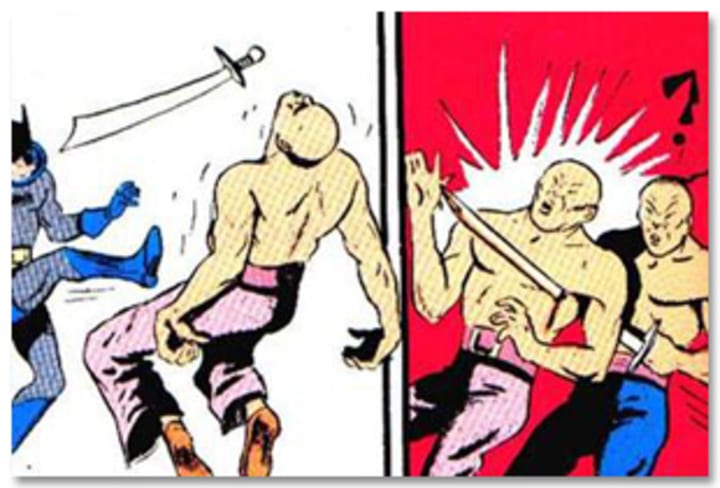
Detective Comics #37
In "Spies" Batman confronts foreign spies who work for someone named Elias Turg. The plan was to destroy an American vessel to start an international crisis. Elias Turg is actually Count Grutt. When Batman corners the Count, he throws a sword at the detective, only to miss and instead flies into the door behind Batman. After a few punches around the room, Count Grutt falls from Batman's punch and lands on the blade protruding from the door, impaling him through the back of the neck.
A "queer case" as Batman puts it, but he still is not softening up to his deadly ways yet. Instead, he simply states "Dead! It is better that he should die!" Otherwise, his plans would lead to countless deaths in war. Perhaps Batman is onto something here though. This is 1940 though, in some time the United States will be involved in World War II though.
Detective Comics #38
A year in and finally they introduce Robin The Boy Wonder! Ever seen 'Robin's Reckoning" from Batman: The Animated Series? Recall that Batman and Robin fight a slew of thugs on a construction site? That came from this issue! Just like the episode, these thugs work for Tony Zucco, who killed Robin's parents. I dare say this is the worst case for Batman. Now he has a child in reckless endangerment and has the child joining his murderous rampage now. It is quite doubtful all of these criminals have perfect balance on a construction site, like a circus performing trapeze artist with training by Batman.
Robin shoves one into the metal beam behind him. He uses a slingshot to hit one target in the head, causing him to lose his footing. We see Robin swing kick three other criminals. Next, Robin picks up one and we can only guess what he did with him afterwards. Then he kicks another man off the beam he stands on. Blade, Zucco's confidant, spills his guts and signs a confession. Enraged, Zucco pushes the man to his death, calling him a "rat!" Does Batman save Blade? No! Does Robin save him or does Batman ask Robin to save Blade? Not at all! Instead, he has Robin take a picture of Blade falling to his death, to add more evidence to convict Zucco. Matter of fact, this was part of the plan. Hard to charge a minor for murder, but we can charge Batman!
Batman #1
The Caped Crusader finally got his own series a year into his run. We have the debut of The Joker, with his own body count and Catwoman as well. The body count continues with Professor Hugo Strange's monster men! Do not let the name fool you, these are not monsters, zombies or simply beasts. Monster men are victims! These are insane asylum inmates that Professor Hugo Strange experimented on with a special serum that turned them into these hulking beasts.
Some thugs are driving a truck with a Monster Man in the back. Batman flies in, looking through his crosshairs as he targets the truck, "Much as I hate to take human life, I'm afraid this time it's necessary!" Hypocrite or is Batman suffering from amnesia? Maybe the detective is delusional! The truck crashes head first into a tree and we never see the thugs again. A rope descends from the Batplane around the Monster Man's neck. Batman pulls up, comparing the Monster Man to a steer and says "He's probably better off this way", because apparently Batman knows what's best for the life on an individual.
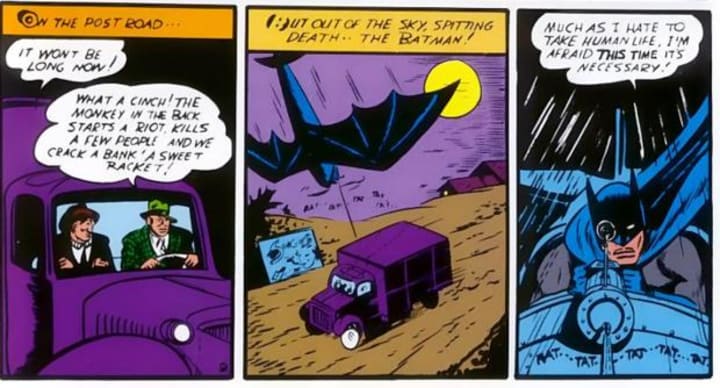
The final Monster Man goes the King Kong route, climbing up a skyscraper. Of course, this Monster Man was also inside a truck, that Batman shot up, crashing the truck and ultimately killing the thugs inside driving the vehicle. The vigilante uses bullets at first to take down the Monster Man, much like King Kong. Strangely, the Monster Man has bulletproof clothes, yeah you figure that one out. Finally, the Batman falls back on his chemical warfare of gas pellets which causes the Monster Man to fall to his death.
Let us retouch that common question of why doesn't he just kill The Joker? Even Jason Todd puts forth this question to his one-time mentor and father figure in Under The Red Hood. Again, proving this is a provenly popular and insightful question. In "The Joker's Return" the Harlequin of Hate murders eight people! Due to Batman simply taking The Joker after their first encounter, stating he was too dangerous, he should have known better. He's too dangerous to be kept alive and now the blood of nine innocent people are on Batman's hands. Understand, this is by no means a condemnation on Batman and his practices, but it is one way to look at his actions and choices.
Final Body Count
20 people are dead, thanks to The Dark Knight. Eight of those are due to The Joker's Escape from prison and six are actually from the hands of Robin! If we do not count those victims of The Joker's then we drop it down to 12 people! Remember, given Batman's presence and legal guardianship of Dick Grayson, he can be legally held responsible for this minor's crimes. Now, there is one discrepancy. Doctor Death did not die! Yes, he was left to burn to death as Batman offered him no help or mercy. Instead, the doctor returns a burn victim in the following issue. Batman strangely leaves him tied up at the end of that issue. However, a double digit murder count is still a feat. Showing he's averaging one death per month.
Understandably, you can make exemptions with some like the Mad Monk and Dala, they are vampires after all and undead. Batman kills vampires in the Batman: Vampire Elseworld series. Some scenarios are not premeditated murder and can perhaps be equated to manslaughter. These include Alfred Stryker or Count Grutt for example. Zack Snyder falls back on this, in his interpretation of the Dark Knight in Batman v. Superman: Dawn of Justice. There is a sense of 'well it's not my problem that he fell on that blade' and Batman does capture this quite well with many of his comments.
Now many fans will comment and say 'well this is not canon!' DC Comics is known for having a baffling, often as times conflicting and paradoxical continuity of sorts. What we know here as The Golden Age Batman will one day be established as the Batman of Earth-Two, a parallel Earth where heroes did indeed fight during World War II. This is the same Earth of the Golden Age incarnations of The Flash (Jay Garrick) and The Green Lantern (Alan Scott). Earth-Two does not come into DC Comics history until September of 1961. It was basically an excuse to keep the versions we know of characters like The Flash (Barry Allen) and Green Lantern (Hal Jordan) with the likes of Batman and Superman. Hence, this was a late afterthought, not something planned from the beginning. In addition, it allowed them to keep their original heroes young. Otherwise, Batman should be on his way to retirement by then.
We have to keep in mind these stories came from the creators of Batman themselves! Never were they planning a 'gotcha' moment. Furthermore, saying these do not count I feel discredit these stories and the creators' hard work behind them. By saying these are not canon, you are saying they do not count and therefore they do not matter. It was because of these stories for over two decades that would later go on to give us countless more Batman stories and new characters. Without the original Batman stories you do not have the movies, T.V. shows and video games. Batman was not birthed in 1961 but 1939! Denny O'Neil admits to going back to this era for inspiration when he took up writing Batman. Frank Miller also claims to look back to this time as well when he penned The Dark Knight Returns. It is fine if you do not like the idea of Batman killing and are morally opposed to it. Still, we have to accept this as part of his history, warts and all. It is no less different than embracing all of the wrongs with American history like slavery for example. No one says you have to like it, you just need to acknowledge it.
If you like what you read here, please feel free to leave a like and a tip.
About the Creator
Skyler
Full-time worker, history student and an avid comic book nerd.
Enjoyed the story? Support the Creator.
Subscribe for free to receive all their stories in your feed. You could also pledge your support or give them a one-off tip, letting them know you appreciate their work.




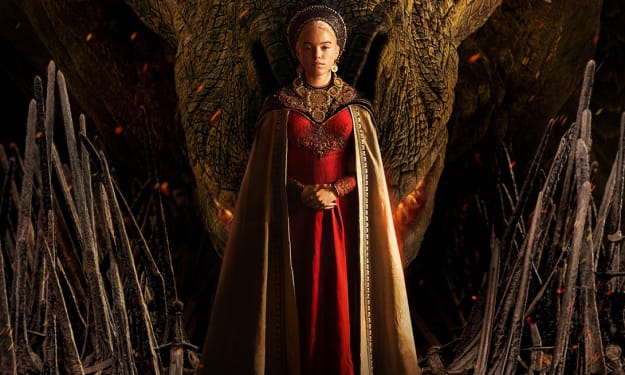

Comments
There are no comments for this story
Be the first to respond and start the conversation.